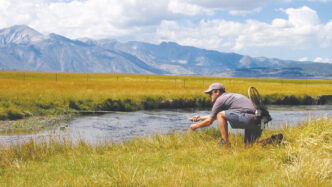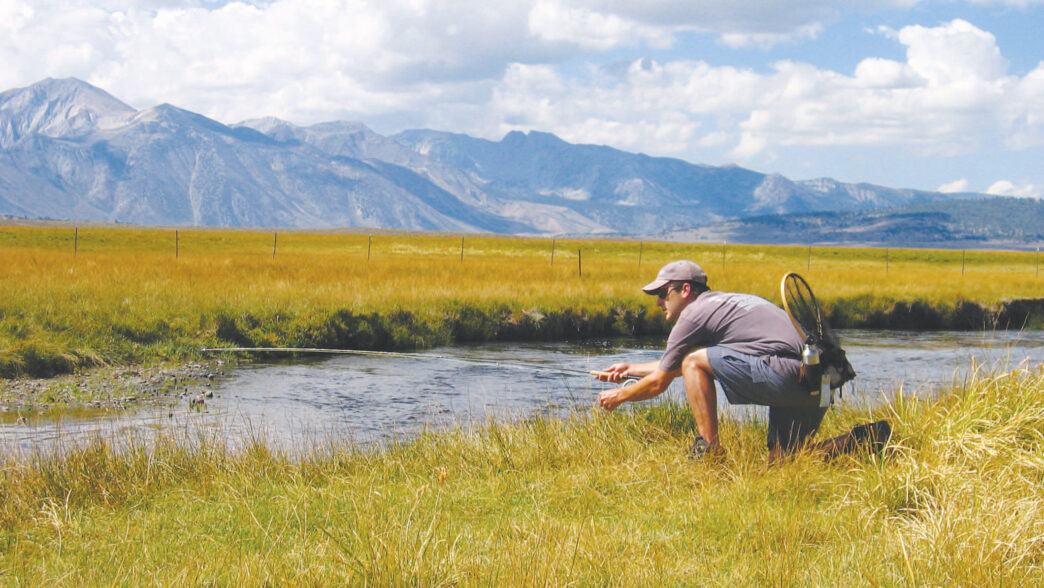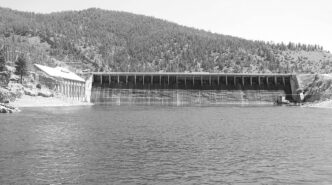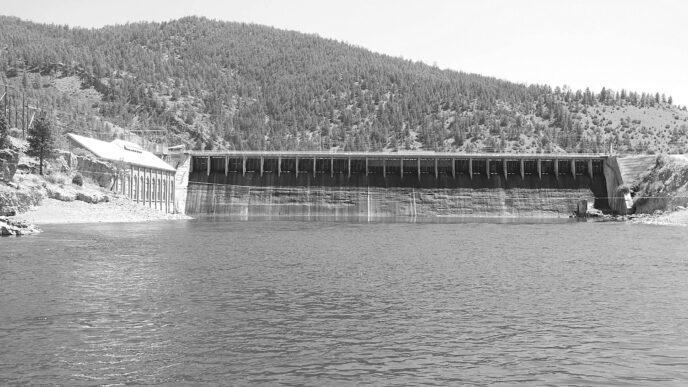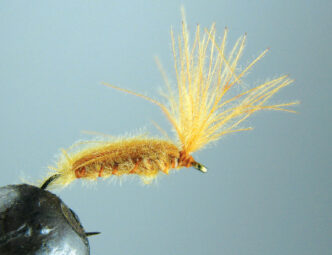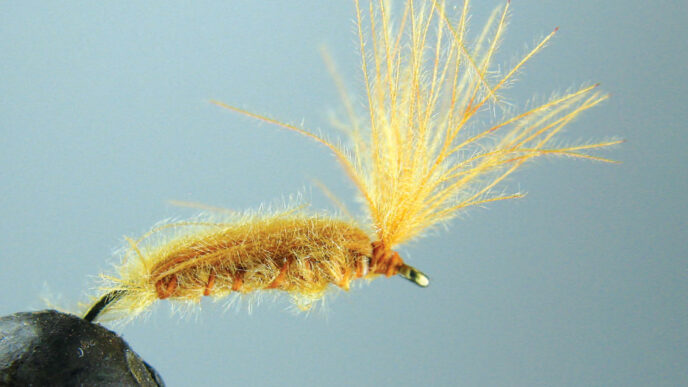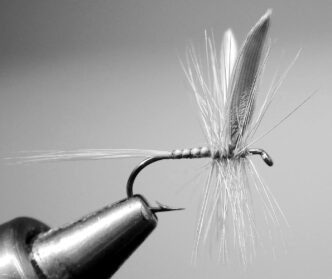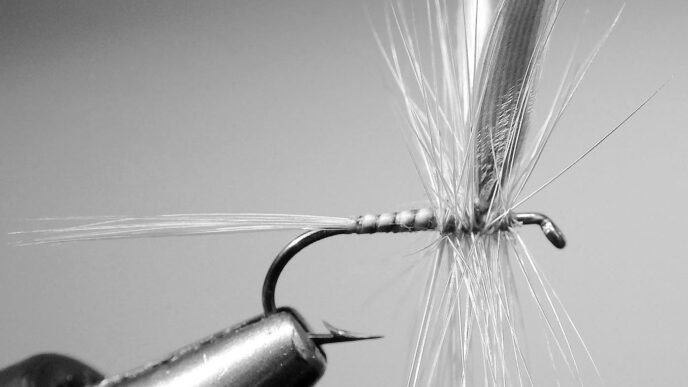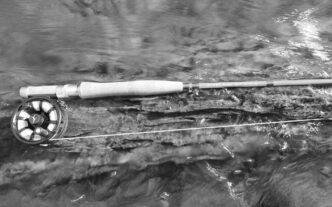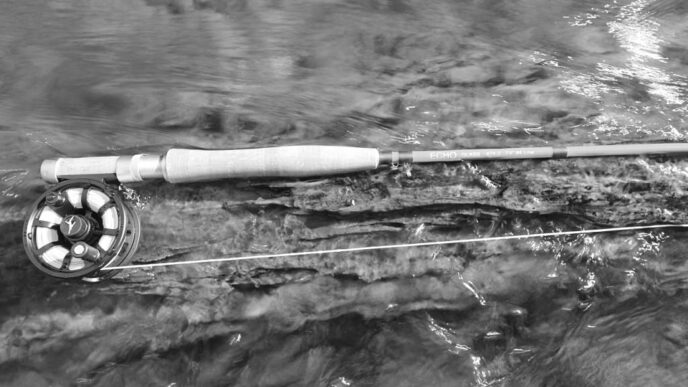You approach a stream and spy a 24-inch rainbow trout sipping bugs off the surface. What would you do? You probably would not amble up to the edge of the stream to get a better view or start casting immediately. More likely, you would freeze and then either slowly backtrack or sink to your knees to get out of sight.
You would do this because you instinctively know that a fish alerted to your presence is difficult to catch and that a frightened fish cannot be caught. So with your heart pounding, you plan a strategy for getting into position to make the best possible cast without scaring that fish. You know that you will need to be stealthy if you are going to have even a chance of getting that trophy trout. But what, precisely, would you do next? And why would you make your approach in this situation an exception to how you usually fish, rather than the rule?
Thirty-five years ago, Sheridan Anderson wrote a fly-fishing primer titled The Curtis Creek Manifesto. Although it contains cartoonlike illustrations, this enduring little book is a serious work. It was my daughter-in-law’s textbook for her flyfishing physical education class at the University of Oregon. It’s packed with flyfishing principles, especially regarding stealth. Throughout his manifesto, Anderson emphasizes the importance of sneaking up on fish. He insists “that many potentially fine anglers have relegated themselves to the legions of mediocrity simply because they don’t learn to stalk.” Instead, Anderson writes, “When I was a kid I used to pretend that each likely looking spot was an enemy machine-gun nest and would approach it accordingly — one false move and it wuz curtains for me and the whole platoon.”
I’m sure many of us would consider this same approach in the above scenario or in any situation in which it’s certain that the prize is the proverbial trout as long as your arm. However, very few of us employ this degree of stealth regularly, if ever. The reason, of course, is that we assume that not every likely looking spot will be holding a trophy trout. But how often have you walked up to the water’s edge and had some really big trout scurry for cover? I’ve done it more times than I wish to admit.
Many years ago, my two teenage sons observed the Department of Fish and Game electroshocking the upper Owens River on the former Arcularius Ranch near that river’s headwaters. Two fly fishers, after nymphing a shallow run without success, told my boys that there were no fish in that stretch of water just as the DFG staff were setting up for the census taking. Out of curiosity, my boys decided to hang around and observe the electroshocking. They were amazed to see that the section that had “no fish” actually produced many fish and some big ones, two in the 24-inch range. The lesson is that you really do not know what a likely looking spot might be holding.
If you want to become a better fly fisher or want to increase your chances of catching more and bigger fish, you may want to be more stealthy. I am not suggesting that you crawl up to every riffle, run, and pool as if it were an enemy machinegun nest, but rather that you size up every fishing situation and consider and implement practical stealthy approaches and techniques to catch trout off guard.
Dress for Success
In 1662, 14 years before the publishing of the Izaak Walton and Charles Cotton edition of The Compleat Angler, Colonel Robert Venables wrote a discourse titled The Experienced Angler, Or Angling Improved. In it, he advised: “Let the angler’s apparel be sad dark colours, as sad greys, tawny, purple, hair or musk colour.” The idea that anglers need to blend in with their environment has been around for at least 350 years, and it seems to be seeping into the consciousness of more and more fly fishers. So if you don’t already, avoid wearing bright colors such as red, yellow, orange, pink, and white. Instead, wear colors that match the surroundings in which you will be fishing. In nature, predators blend in with the environment. It can’t hurt if you do, too, and it might just give you that stealthy edge.
When and Where to Be Stealthy
Different environments require different methods. Water types vary from small, clear, still, and low waters demanding the highest degree of stealth to big, roily, and deep waters that may require less stealth. Also, riparian vegetation and terrain vary, thereby providing a wide array of challenges and opportunities for the stealthy flyrodder. As strange as it may seem, fishing pressure also may dictate the degree of stealth to employ.
The public section of Hot Creek, below Hot Creek Ranch near Mammoth Lakes, is one of the most heavily fished waters in California. Its trout see an almost incessant parade of anglers, so it is reasonable to assume that the fish are aware of the streamside commotion, but are not alarmed by it and continue eating. And continue eating they do, as evidenced by the many healthy wild brown and rainbow trout in that nutrient-rich spring creek. So fishing streams with a lot of angling pressure may not require you to be stealthy to an extreme. On streams such as the public section of Hot Creek, presentation of the fly is paramount, and stealth takes on a subordinate role.
However, the Hot Creek public section is an anomaly. Most waters require stealth in addition to presentation and other fly-fishing skills simply because trout in waters that see little angling pressure spook more readily. In contrast to the Hot Creek public section, it is common to see anglers on the adjacent, pay-for-play Hot Creek Ranch kneeling or crouching in the streamside grass in pursuit of the wary fish in that private water.
Remember — if you can see the fish, it can likely see you. That doesn’t mean a trout that sees you cannot be caught. A trout, even a wild trout, holding near the bottom of a stream may be aware of an angler, but not be alarmed because it feels secure due to the volume of water between it and the predator. For this reason, a well-presented nymph might take this fish, if it’s the right pattern. Still, it is axiomatic that your chances are better when the trout is not aware of you.
A Basic Approach
Fish see to the side (with monocular vision) and to the front (with binocular vision), but do not see directly to the rear. For this reason, it is generally better to approach fish from behind — or from downstream, since trout usually face into the current. In fact, one of Sheridan Anderson’s eleven commandments is “Thou shall fish upstream.” Fishing upstream, as we have all learned, also facilitates the drag-free drift of the fly. It also has another advantage: if you spook fish, they generally take off downstream. Therefore, they will be less likely to alarm the fish you’ll subsequently target upstream.
This does not mean that you should not cast downstream. Casting downstream on the Hot Creek public water, especially with a big upstream mend, can be very effective. In other situations requiring more stealth, you may need to keep out of the trout’s view when making a downstream cast. There is something to be said about having the fly, preceding the leader, drift naturally into the fish’s window: it can be absolutely deadly.
What I am about to say may seem heretical to some, and it definitely is counter to what I learned when I started fly fishing: don’t cast to every possible spot. Anglers who work their way up or down the bank hitting every possible spot have the tendency to spook fish, no matter how stealthy they try to be. To be candid, in my experience, most don’t even make an attempt at being stealthy.
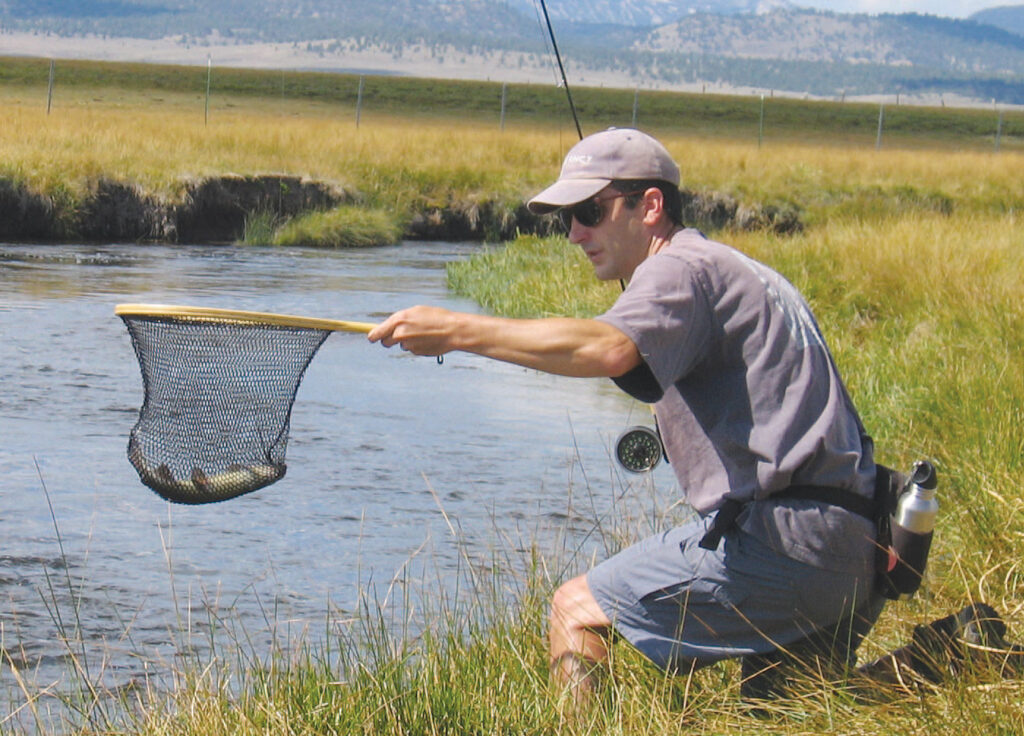
Instead of trying to fish every possible lie, pick out a promising spot some distance upstream or downstream, then mentally map out a strategy for putting yourself into position to make the next cast. This will likely mean backing away from the water, moving roughly parallel to the stream, then working your way slowly, quietly to get into position. As you approach the stream, take advantage of the vegetation, rocks, and other forms of cover. If you are fishing an area such as the upper Owens River, which flows through rangeland north of Lake Crowley, there will be no rocks, trees, or shrubs to conceal your approach. There will only be grass, which will probably be chewed to stubble by grazing cattle. So without adequate cover, you will need to start crouching lower and lower as you approach the stream and (this is the point where many anglers would draw the line) start crawling as you get to within two or three rod lengths of the water. Sheridan Anderson suggests casting on your knees when you’re within 30 feet of the bank. This may sound extreme to some, but it is actually a proper gentleman’s tactic compared with other tactics espoused by Anderson. For example, he advocates crawling in the water downstream of a cascade, then flicking a fly onto the elevated pool. I tried this tactic in my younger days, though, and it does work.
Distance Can Make You Invisible
Over the years, I have been fortunate to have met and fished with true fly-fishing experts who were very willing to share fly-fishing knowledge and techniques they had acquired over several decades. One was Mas Okui, the “Unconventional Master of Hot Creek,” as this magazine once called him (see the January/February 2000 issue of California Fly Fisher). Another was Ken Hall of Las Vegas, formerly of West Hills, California. When I first met Ken over 20 years ago on the Arcularius Ranch, he had already been fishing the upper Owens River for 35 years.
Ken employed techniques that at first appear to be the antithesis of stealth. He would stand at the edge of the upper Owens, which flows through the ranch down to Lake Crowley, and cast weighted black Marabou Leeches 60 feet downstream to the opposite bank. “The trick,” he would say, “is to splat your streamer down within inches of your target,” which usually meant an undercut bank, “then retrieve with a stripping and bumping motion.” That is, he would strip in line, then twitch the rod tip, strip and twitch. The strikes would be immediate and violent, producing rainbows and browns up to eight pounds. Ken said that shorter casts rarely had the same effect.
But this technique actually is very stealthy. Depending on the depth of a fish, an angler 60 feet away may present only a compressed, almost indiscernible image in the fish’s visual periphery, or the angler may be entirely within the fish’s blind zone. Either way, Ken had discovered empirically what he needed to do in order to become invisible to the fish and to catch them off guard.
I met Ken early one morning on the Arcularius Ranch when, using the above technique, he caught and released five trout over 20 inches in about half an hour. I saw the photos. (Ken would travel light — a fly box in his shirt pocket, a net, his rod and reel, and, in those days, a Polaroid camera slung over his shoulder). He would not cast to every spot (see above) but instead would jump in his pickup and dart from one turnout to the next, making a couple casts to the best spots, then move on. It was like speed dating.
Some of Ken Hall’s dry-fly and wetfly tactics also appear to counter the rules of stealthy fly fishing, but again, they really make him invisible to trout. He would fish a specialized caddis pattern, which he referred to as a “sedge.” It was a modified King’s River Caddis on a size 16 hook with a stripped peacock herl body (today, he uses a tan goose biot) and a grizzly hackle and tail. (Yes, a tail on a caddis.) He would tie it to a 15-foot leader and while standing next to the edge of the river would cast it 30 feet downstream along the near bank, feeding out line with the current until the fly drifted an additional 30 feet. When the line is fed out carefully and skillfully, this doesn’t cause unnatural drag. If there were no takes, he would dredge it back as a wet fly. He would often just let the submerged fly waft in the current, tethered to 60 feet of line and leader. The first time he demonstrated this technique to me one evening, a fish smashed the fly after about half a minute. I gave out a “Woohoo!” in excitement. Ken, however, seemed a little disappointed, because the rainbow was “only” 17 inches.
Rangeland or meadow streams without abundant riparian vegetation may not provide much cover to hide behind, but they provide a snare-free environment in which to make longer than normal casts such as these, and they can make you invisible to fish.
Use What Nature Offers
Conversely, in most streamside environments, such as the eastern Sierra’s Rush Creek, Green Creek, and Rock Creek, there’s so much riparian vegetation that it’s usually regarded by fly fishers as an annoyance. This growth can make access to the water difficult and can readily snare your flies. But riparian growth, along with large rocks and boulders, can provide cover, allowing the stealthy flyrodder to sneak up really close to the water. If a conventional cast would be difficult because of riparian vegetation, a flip cast, bow-and-arrow cast, or dapping can be employed.
(Dapping is the stealthy art of alighting your fly onto the water without casting. Usually, the rod protrudes over streamside vegetation or an embankment. My little granddaughters use this technique with great effect on their local bluegill pond. A tip: to prevent the weight of the fly line from pulling the leader back into the guides when dapping, simply double a portion of the line through the tip top. This will stop the line from slipping back through the guides, and the line will release instantly when you get a strike.)
When you sneak up to the water, remember that motion can alert your prey. Casual observation of cats and herons will reveal a secret of predatory success. They move very slowly and pause often, remaining motionless for relatively long periods when stalking. Once you get into casting position, you may want to remain motionless for a couple of minutes before casting. Why not take time to observe the water or take in the beauty of creation? You may be surprised by what you see, and besides, a little respite may be all that is required to make you part of the environment.
The wind, which is often cursed by fly fishers, can also be a blessing. If at all possible, attempt to coordinate your stalking movements with the wind as it rustles the surrounding foliage. That will really help to conceal your approach to the water. The wind-rippled surface can also disguise your cast and mask your presentation mistakes. Of course, a strong wind can make casting difficult, but be aware of the advantages that a moderate wind provides.
Always try to move and even cast in the shadows when possible. Shade has a tendency to mute colors, and it provides a backdrop into which you can blend. Sunlight accentuates colors and sharply outlines an angler’s form, particularly when it is viewed against the sky. Of course, there are times when shadows work against you, especially during the early morning and late evening. Avoid having your shadow and that of your rod fall on the water.
Wading
Wading can be the antithesis of stealth. Generally, try to avoid getting into the water, especially when fishing small streams. But often, you have no other choice. If you need to wade, enter the water slowly and unobtrusively, downstream of your quarry or the targeted lie, and cast upstream. Of course, you can cast downstream if there is broken water between you and your intended downstream target. Larger waters such as the East Walker River or other waters with riffles, which help mask the unnatural sounds of you trudging over the substrate, are the best waters to wade. Also, the churning water tends to hide you.
Be aware, however, that big waters can be dangerous to wade, and slippery substrates can make even small waters treacherous. In more placid waters, it is axiomatic that you need to enter the water very s-l-o-w-l-y and quietly to minimize generating the sound waves that alert fish, even those facing upstream. Sometimes, only minimal wading is needed to move into position away from streamside obstructions in order to make a successful conventional cast.
The Complete Angler
Stealth complements other fly-fishing skills, such as casting, choosing and presenting the right fly, and reading the water. Indeed, successful stalking relies on mastery of other components of the sport. It would be of little use, for example, to jockey yourself into range of a trophy trout and not be able to present the fly naturally. Conversely, it would be pointless to spook a trophy fish before you can let fly that perfect cast.
Stalking, like other fly-fishing skills, takes more than just a knowledge of what to do and not to do. It takes patience and discipline. If slinking in the shadows and painstakingly approaching a good spot produces nothing, it’s easy to get discouraged and return to the comfortable habit of incessantly plying the water. After all, one of the great things about our sport is that you can have fun casting while not catching fish. However, “Despite rumors to the contrary,” according to Sheridan Anderson, “the paramount objective is to catch fish.” If your paramount objective is to catch the biggest or most difficult fish, you must be dedicated to stealth and have the discipline to employ it regularly. You do not need to sneak up to every likely looking spot as if it were an enemy machine-gun nest — that is not practical. But you can assess every situation and ask yourself, “What can I do to approach this water without alerting fish to my presence?” Then do it, and you’ll start catching trout off guard.



